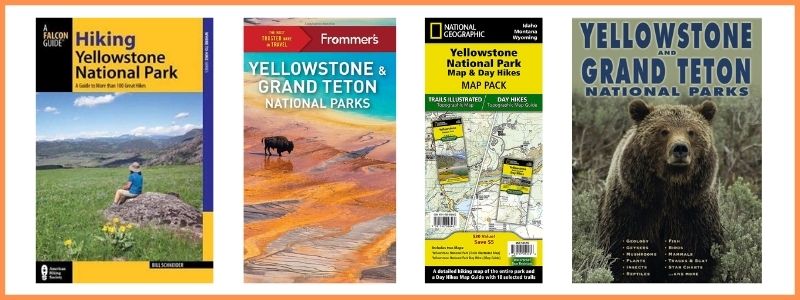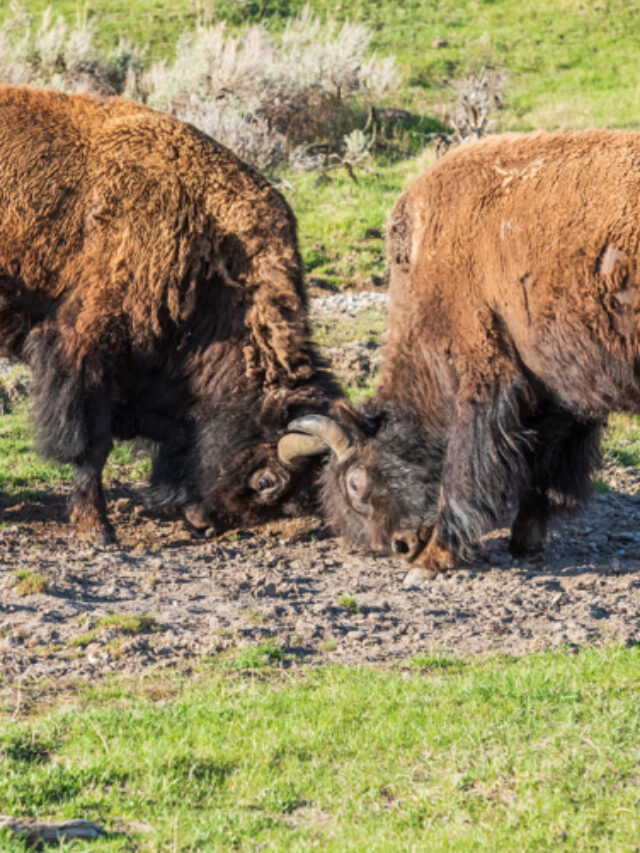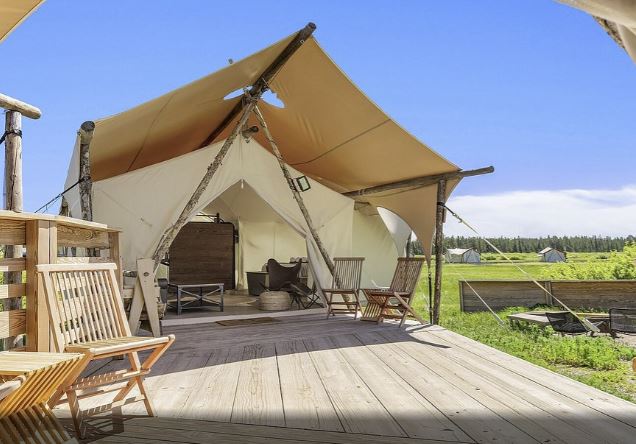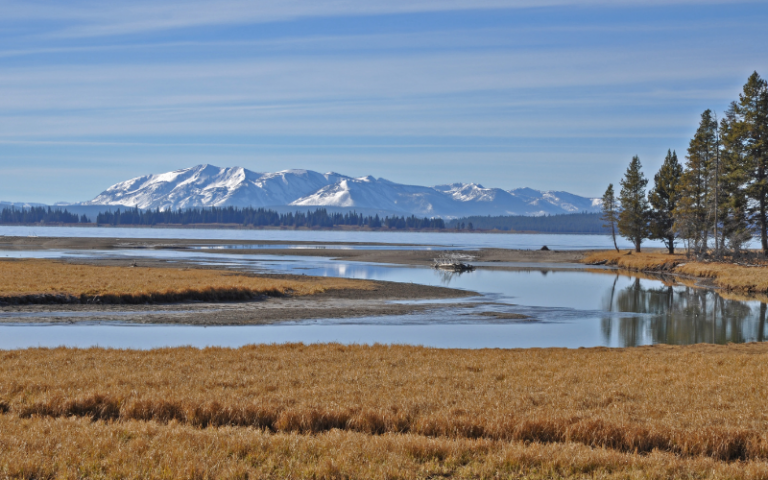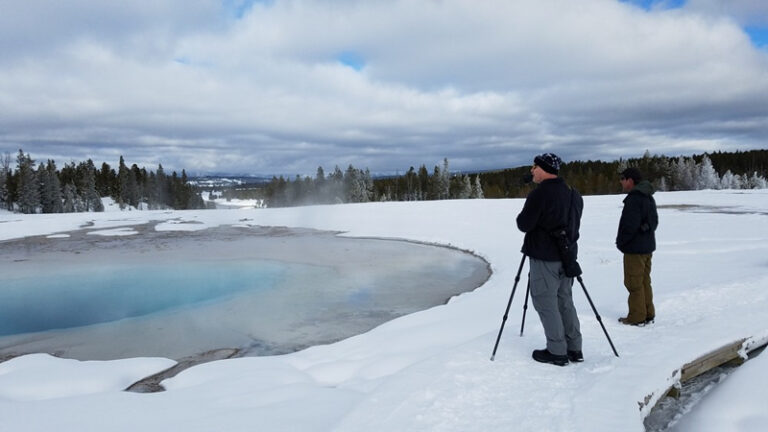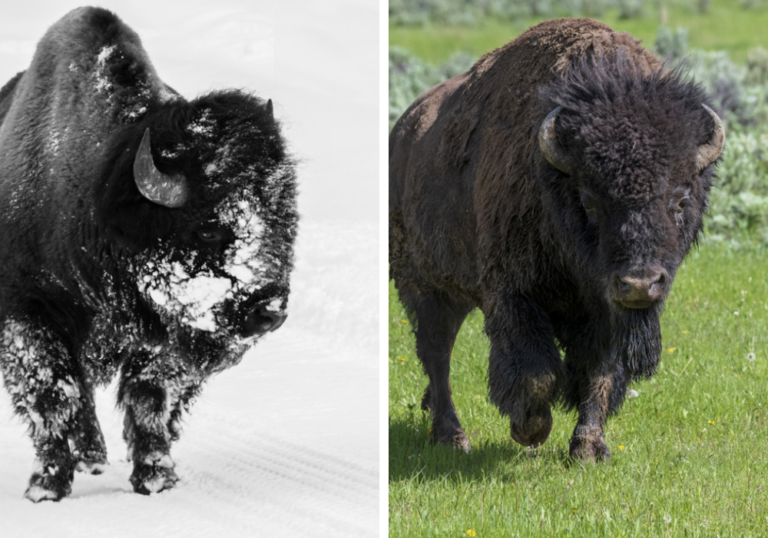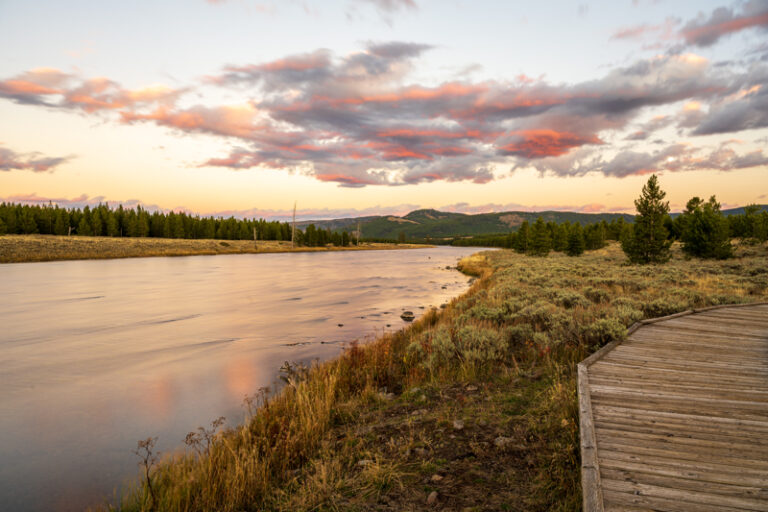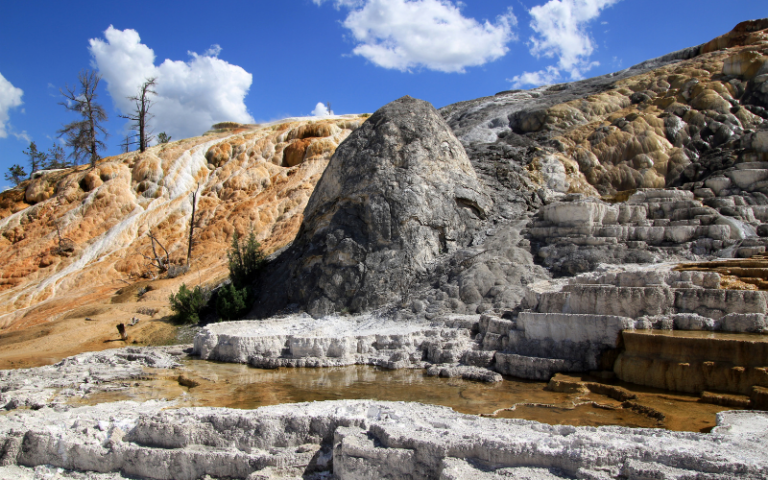Best Places to See Wildlife in Yellowstone National Park + Map
This Yellowstone travel guide will detail the best places to see wildlife in Yellowstone National Park.
Visitors to Yellowstone are anxious to see large herds of bison, bears, elk, and wolves. Check out this list of places to spot the various animals in Yellowstone.
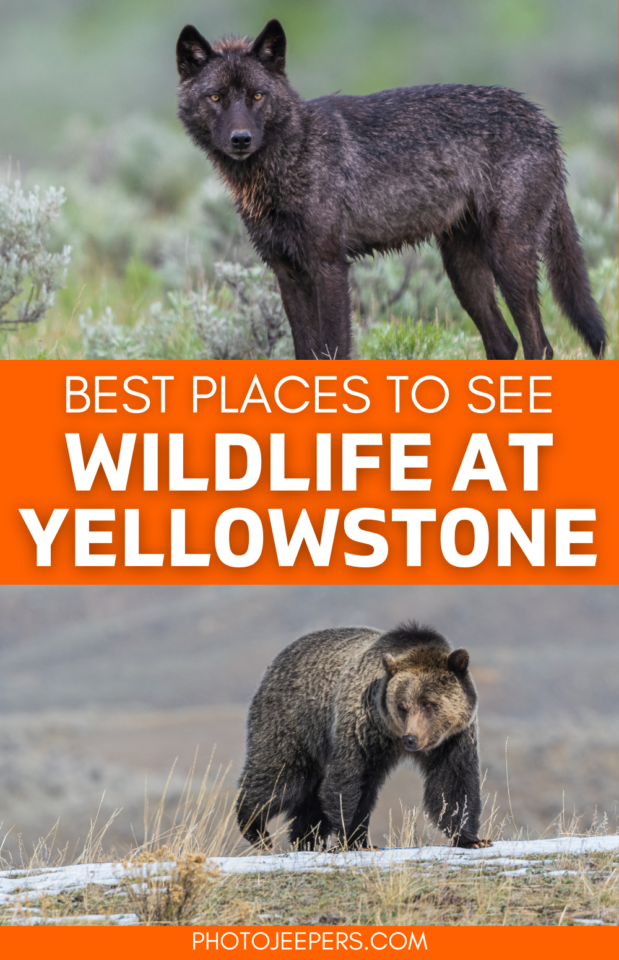
We also share the best times to visit Yellowstone for wildlife detailing the animals you’ll see each month of the year.
This guide is based on our various trips to Yellowstone during all four seasons. Luckily we live close enough that we can visit Yellowstone often.
Below we share our tips for locating and photographing wildlife based on the 10+ years going to this amazing park! Note that we experience wildlife at Yellowstone from our car and pullouts in the road, not from backcountry hiking.
Yellowstone National Park Wildlife
Take a visual tour through Yellowstone National Park to see the stunning wildlife you’ll see at the park!
Safely Viewing Wildlife in Yellowstone National Park
All Yellowstone wildlife is wild and unpredictable. Too often visitors underestimate the dangers of bison and elk resulting in injuries.
There are basic tips for watching wildlife safely in Yellowstone. These guidelines are meant to l keep both yourself and the animals unharmed:
- Never approach wild animals or follow them.
- If an animal approaches you, back away slowly to keep a safe distance.
- Use binoculars, a spotting scope or telephoto lens to view or photograph Yellowstone wildlife.
- As a general rule of thumb, if an animal reacts to your presence, you’re too close. Move away.
- When possible, hike in groups of at least 3 people.
- Stay inside or close to your car when observing black or grizzly bears.
- You must stay at least 100 yards from bears and wolves, and at least 25 yards from all other animals, including birds.
We’d like to add two tips from things we’ve seen and experienced in the park:
- Park in designated parking areas or pullouts. DO NOT hop out of your car in the middle of the road and leave it unattended while you run to take a picture of an animal.
- Listen to the rangers! They do their best to allow everyone to watch the animals at a safe distance. One person crossing the line can ruin it for everyone.
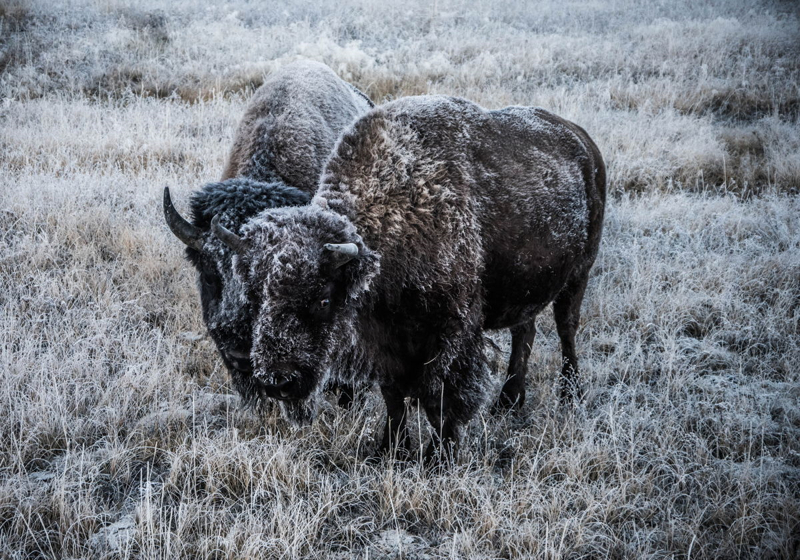
The Best Time to Visit Yellowstone for Wildlife
There is no guarantee for the best time of day or month of the year to see wildlife in Yellowstone National Park.
But there are best times to visit Yellowstone when animals are seen more frequently. Here’s what we recommend based on our years of visiting the park.
Best Time of Day to See Wildlife in Yellowstone
You really need to be in the park at dawn and dusk for the best chances to see bears and wolves.
We like to plan to be in Lamar Valley or Hayden Valley before sunrise. This may mean we’re driving through the park in the dark to get to those locations, so drive a bit slower than the speed limit because those dark bison in the road are hard to see until you’re right on them!
Bison can be seen any time of day.
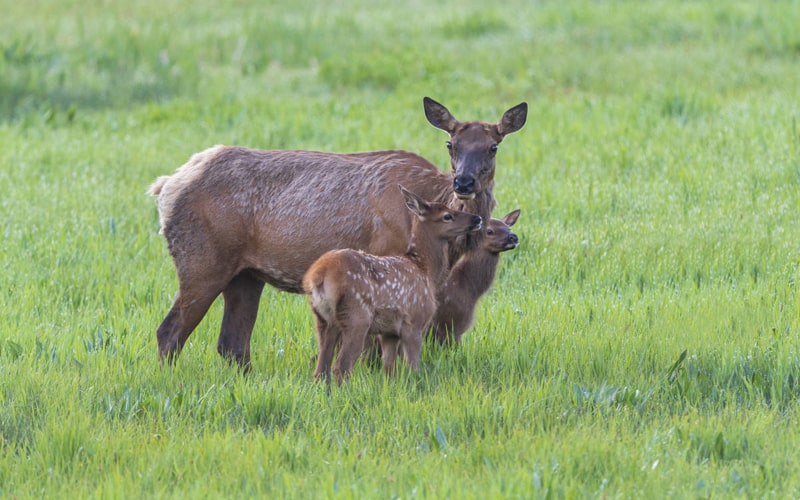
Best Seasons to See Wildlife in Yellowstone
Yellowstone in the Spring is the best season for wildlife watching in Yellowstone National Park. It’s calving season for all large mammals in Yellowstone.
May is a terrific time to see all the animal babies! The bison “red dogs” are fun to watch running around in Lamar Valley. If you’re lucky you can scan the hillsides in Lamar Valley to see wolf pups emerge from their dens. In late-spring, elk calves can be seen at Mammoth Hot Springs.
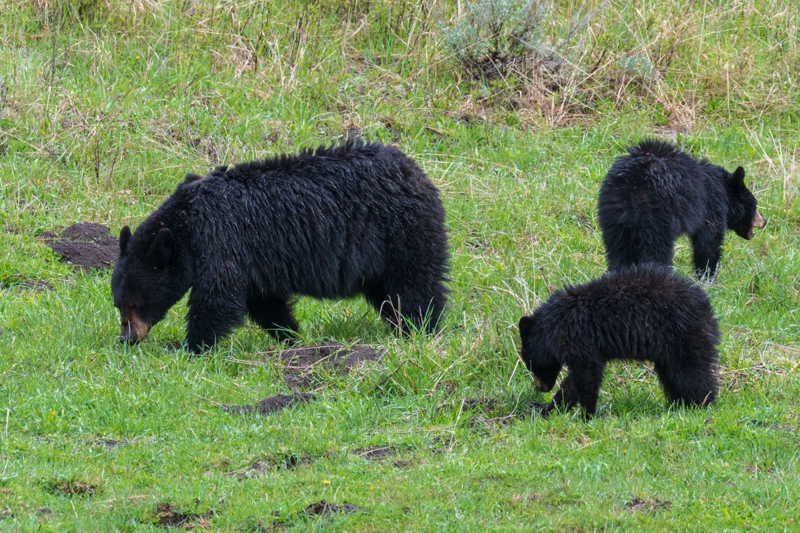
May is our favorite time to see bears in Yellowstone. Black and grizzly bears roam the roadside meadows and valleys searching for winter-kill and other food sources. Black bear and grizzly bear cubs are out, and they’re a big draw for visitors to Yellowstone.
Be sure to carry bear spray at all times. Also note there will be areas in the park that are closed for bear management in the spring.
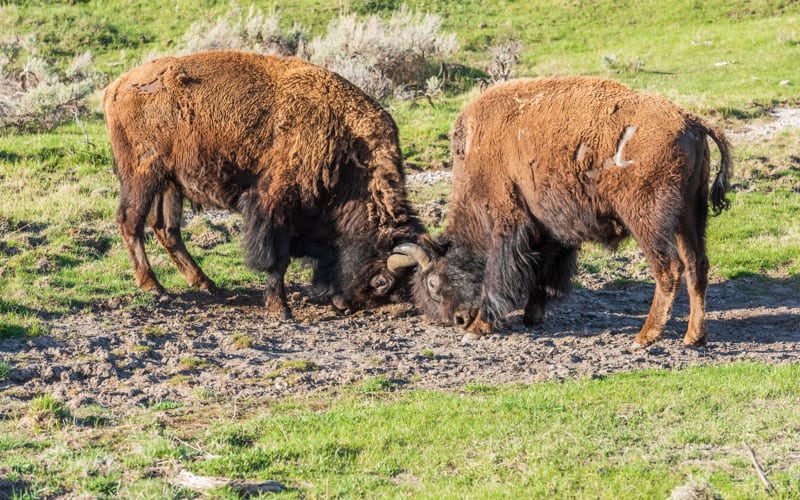
Yellowstone in the Summer is the peak tourist season in the park, but unfortunately it’s the worst season to see wildlife in Yellowstone National Park.
In July and August the hot temperatures push the animals to the higher elevations where they take cover in the shade, making it difficult to see them from the roads in the park.
Bison can usually be seen in Yellowstone at any time of year. August is the bison rut and a good time to see these animals in action, especially in Lamar Valley. Remember to keep your distance, especially during the rut!
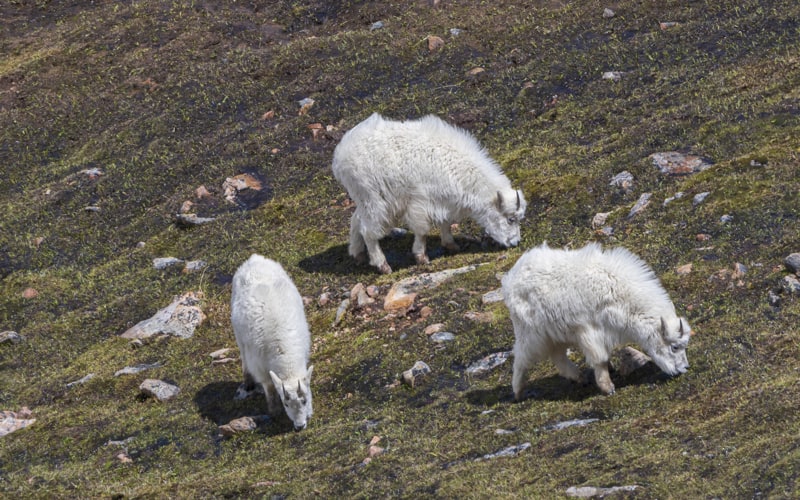
We recommend you continue past Lamar Valley to Cooke City and even drive along Beartooth Highway where the higher elevations mean cooler temperatures. Look for bison, elk, bear, moose, bighorn sheep, mountain goats, coyote, fox, and badgers!
If you’ll be visiting Yellowstone during the summer months, your best chance to see bears or wolf packs is again at dawn and dusk.
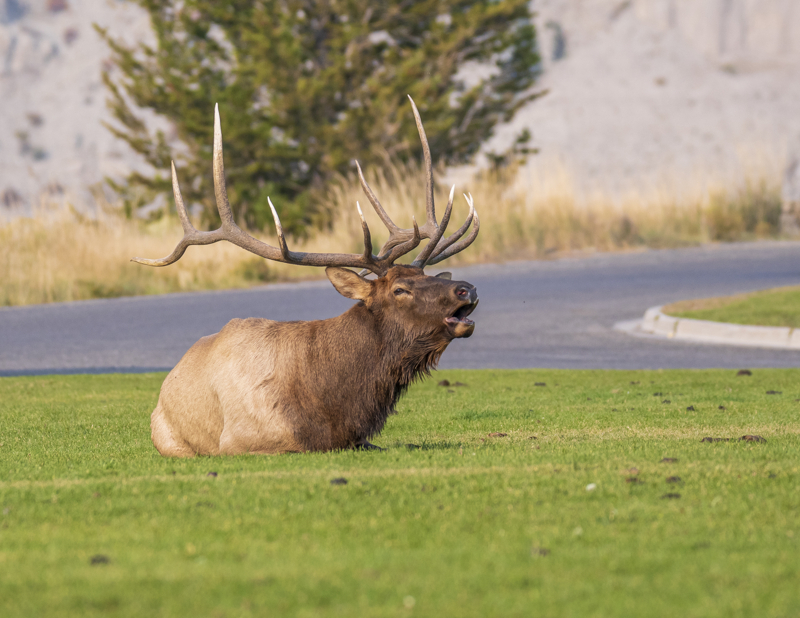
Yellowstone in the Fall is when the black and grizzly bears come down from the mountains and are again roaming the roadside meadows. It’s fun to see how fat the bears are this time of year.
September is the elk rut around Mammoth Hot Springs. It’s a busy time of year due to this cool event to listen to the bull elk bugle and sometimes see them lock antlers with each other. Be sure to keep your distance and listen to the rangers. Elk are known to charge people and cars during this time!
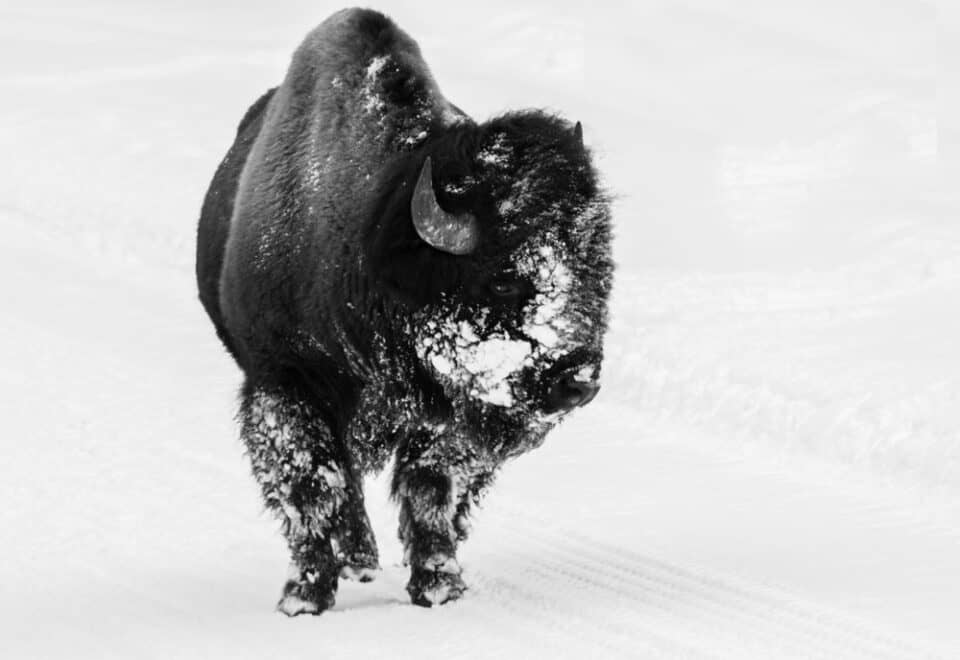
Yellowstone in the Winter is a great time to see animals because they pop against the white snow.
All roads closed except from the north entrance in Gardiner to the northeast entrance in Cooke City. You can access the park from West Yellowstone and the south entrance near Grand Teton by Yellowstone snow coach tours, snowshoeing, cross country skiing or snowmobile tours.
You’ll see bison and elk in the North from Mammoth to Cooke City. This is the only road open for personal vehicles in the winter. Watch for wolves, red foxes, and coyotes in Lamar Valley.
When you take a snowcoach tour in the winter, you’ll see bison around the hydrothermal areas and along the rivers. Trumpeter swans like to hang out in rivers with open water.
We had an exciting encounter with wolves feasting on a bison kill one winter. The snowcoach guides allowed time for everyone to get out to watch and take pictures!
What Animals Can You See in Yellowstone National Park?
Here’s a great list of the wildlife you might see on your Yellowstone vacation, and the areas you’re most likely to see them!
Where to see bald eagles in Yellowstone:
- Madison River
- Hayden Valley
- Lamar Valley
- Fishing Bridge
- Yellowstone Lake
Where to see bighorn sheep in Yellowstone:
- Lamar Valley
- North Entrance
- Tower-Roosevelt Area
Where to see bison in Yellowstone:
- Lamar Valley
- Hayden Valley
- Mammoth Hot Springs
- North Entrance
- Old Faithful
- Madison River
- Gibbon Area
Where to see black bears in Yellowstone:
- Lamar Valley
- Hayden Valley
- Yellowstone Lake
- Tower-Roosevelt Area
- Mammoth Hot Springs
Where to see elk in Yellowstone:
- Lamar Valley
- Hayden Valley
- Mammoth Hot Springs
- Canyon
- Madison River
- North Entrance
- Old Faithful
Where to see grizzly bears in Yellowstone:
- Lamar Valley
- Hayden Valley
- Fishing Bridge
- Pelican Valley
- Yellowstone Lake
- Tower-Roosevelt Area
- Swan Lake Area
- Norris Area
- Gibbon Area
Where to see moose in Yellowstone:
- Pebble Creek (Lamar Valley)
- Northeast Entrance
- Hayden Valley
- Fishing Bridge
- Yellowstone Lake
- West Thumb
- Willow Park (halfway between Mammoth and Norris)
Where to see river otters in Yellowstone:
- Madison River
- Yellowstone River in Hayden Valley
Where to see pelicans in Yellowstone:
- Pelican Valley
- Hayden Valley
- Yellowstone River
- Yellowstone Lake
Where to see trumpeter swans in Yellowstone:
- Swan Lake
- Madison River
- Yellowstone River below Fishing Bridge
- Yellowstone Lake
Where to see wolves in Yellowstone:
- Lamar Valley
- Hayden Valley
- Blacktail Deer Plateau (west of Tower-Roosevelt)
- Canyon
- Old Faithful Area
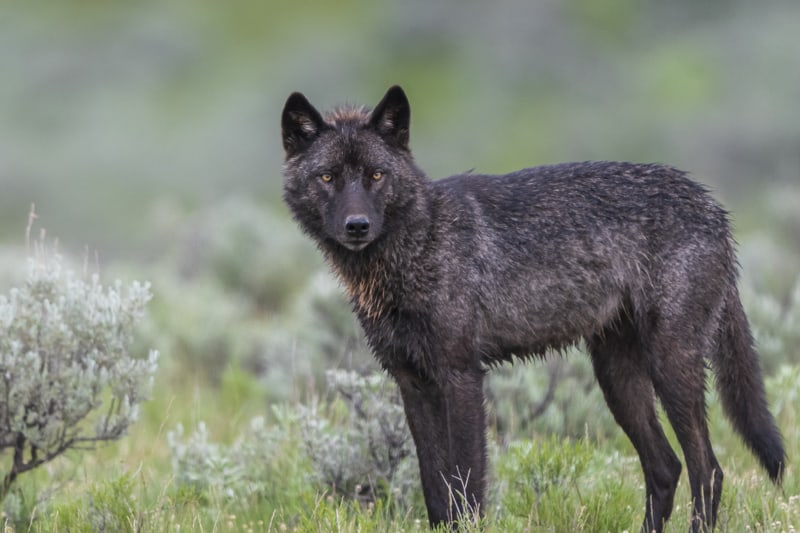
How to Spot a Bear or Wolf in Yellowstone
When bears and wolves are far away, it’s easy to mistake them for a rock or bush. You’ll need binoculars, a spotting scope or telephoto lens to see them most of the time!
Over the years we have come to know the hot spots for bears and wolves in Yellowstone. We take the time to pull into turnouts in those areas to scan the landscape looking for wildlife.
As you drive through Yellowstone, look for groups of people standing outside their vehicles with binoculars or scopes. This usually means they’ve spotted an animal.
Most visitors looking for wildlife in Yellowstone are happy to share information about animal sightings. We’ve had many who let us look through their scopes to see grizzly bears and even wolf pups!
Dusk is a great time to spot bears on the western slopes of hills due to the low sunlight and active time of day.
Yellowstone National Park Map
Use the printable and interactive Yellowstone maps to help you navigate through the park to all the best wildlife viewing locations.
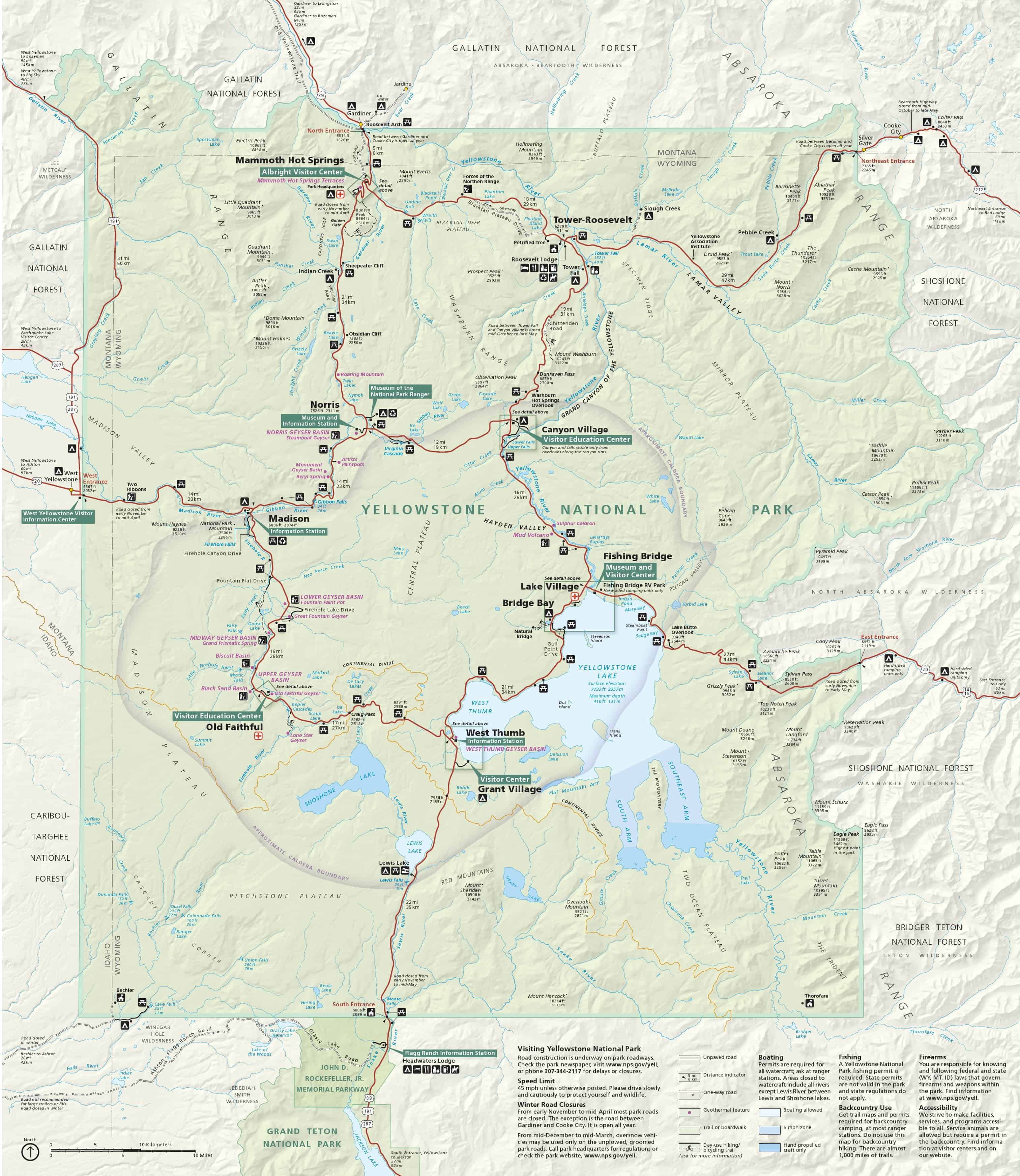
What Are the Best Places to See Wildlife in Yellowstone National Park?
You really need to be prepared to see any animal, at any time, at any location in Yellowstone. Wildlife roams the entire 3,000 square miles of the park, but there are a number of places where they are typically seen.
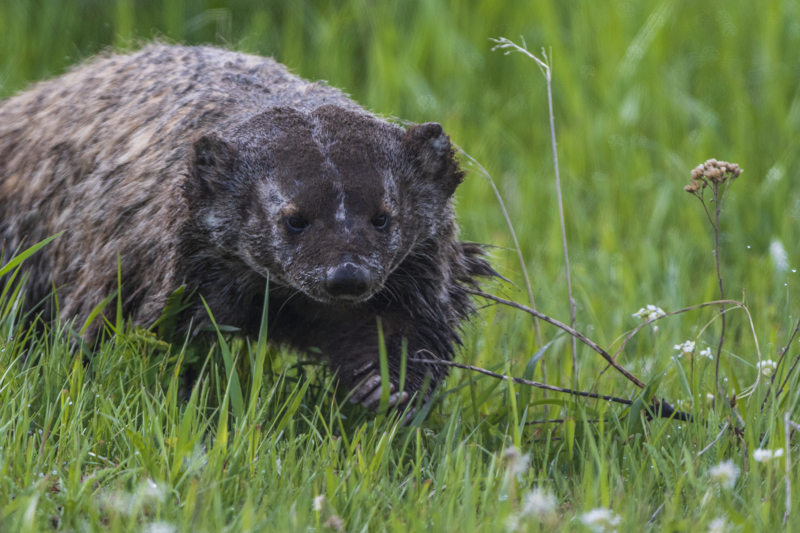
Wildlife in Lamar Valley
For us, Lamar Valley is the top place to see a variety of wildlife at Yellowstone. The grasslands of the park’s Northern Range are often called “North America’s Serengeti.”
The animals that live here are pronghorn, deer, elk, bison, coyote, red foxes, badgers, black bears, grizzly bears, and wolves.
During Yellowstone in the winter the only road open in the park is from Gardiner at the North Entrance to Cooke City at the Northeast Entrance.
Lamar Valley is a must-visit destination in Yellowstone for wildlife viewing opportunities in every season.
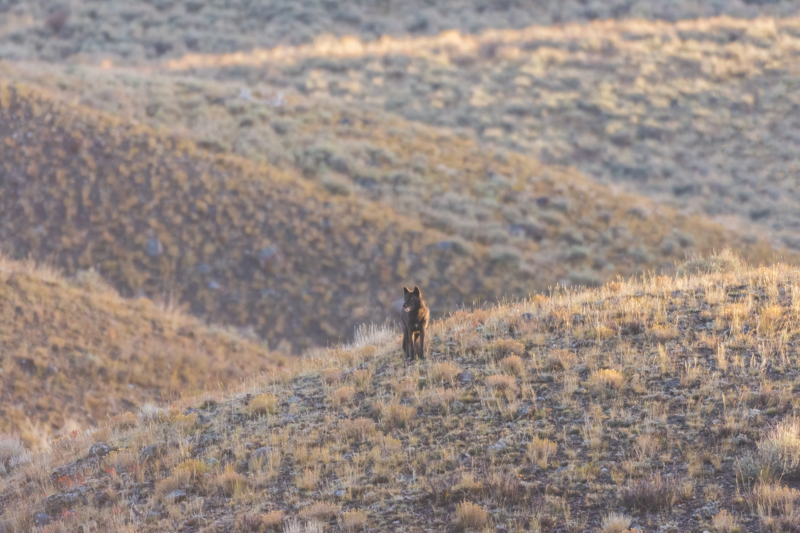
WOLVES: Slough Creek is a well-known area for wolves. We’ve been successful seeing and photographing wolves in this area.
As you enter Lamar Valley, keep your eyes open for wildlife on both sides of the road. Usually people are focused on the river valley. We were stopped once a bit away from a crowd who was looking at the river. We happened to look on the hills behind us to see black wolves! No one else even saw them before they disappeared over the rise!
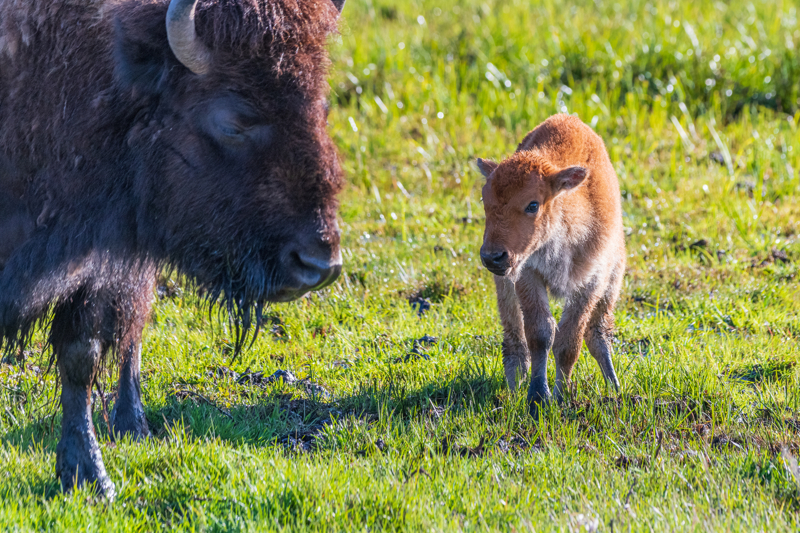
BISON: Bison can be seen roaming all over Lamar Valley! The red dogs are so fun to watch running and playing in the spring. The bison rut happens in August, and while it’s exciting to watch, be sure to keep your distance as the bulls lock horns!
BALD EAGLE & OSPREY: Just past the Slough Creek road there’s an osprey nest on the right hand side. You’ll see two dirt pullouts on the right to safely park to see the nest. We’ve also seen bald eagles in the trees by the river in Slough Creek and the trees by the river in Lamar Valley.
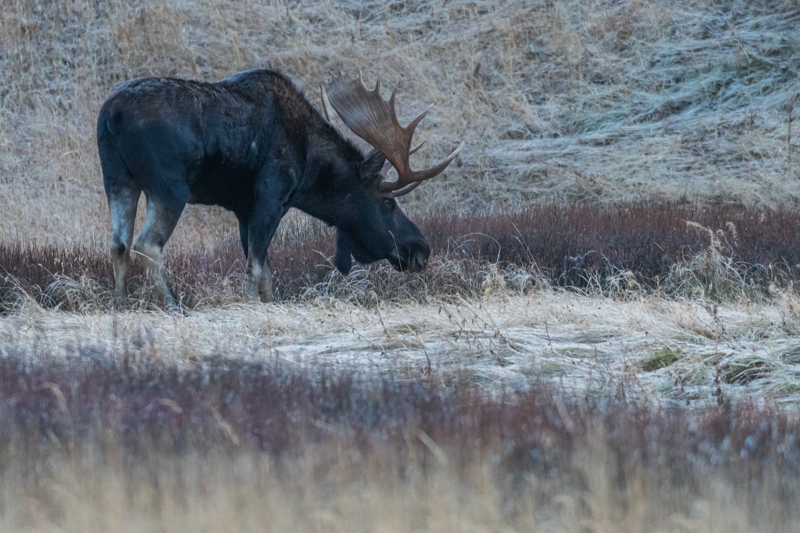
MOOSE: Your best chance to see moose is near Pebble Creek past Soda Butte as you’re driving toward the Northeast Entrance. We’ve had good success seeing them in the valley and along the hillsides in this area. The Soda Butte Creek picnic area and the town of Cooke City are also good places to see moose in Yellowstone.
BEARS: We’ve seen grizzly bears and cubs while driving through Lamar Valley fairly close to the road – close enough we could see them without a scope or binoculars. It’s thrilling to watch these amazing animals at a safe distance!
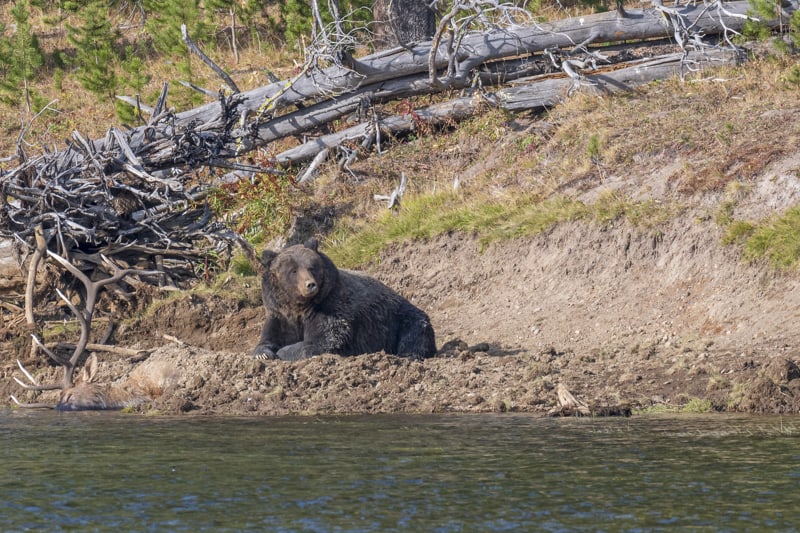
Wildlife in Hayden Valley
A close second to Lamar Valley would be Hayden Valley. It’s located halfway between Canyon Village and Lake Village.
This area was once filled by an arm of Yellowstone Lake. Today it’s home to all of the largest Yellowstone mammals: bison, elk, moose, pronghorn, black bears, grizzly bears, and wolves.
BEARS: You never know when you’ll see bear action in Yellowstone. A famous encounter of a grizzly chasing a bull elk into the Yellowstone River was caught on video. We were lucky to watch the aftermath a day later of a huge grizzly defending the kill from other bears, wolves, and even ravens.
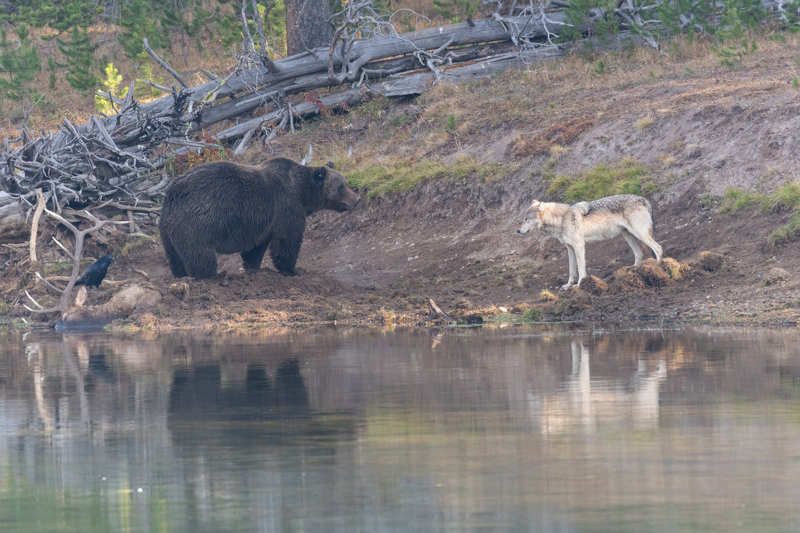
WOLVES: There’s a wolf pack in the Hayden Valley area that you can see close to, or even cross, the road if you’re stopped in just the right spot. We haven’t been lucky to have that experience just yet, but we did see them harass the grizzly with the elk!
BIRDS: A fun stop at LeHardy’s Rapids lets you see the unique harlequin ducks that congregate here! The Yellowstone River in the Hayden Valley is a great place to see trumpeter swans, pelicans, blue herons, osprey, and bald eagles!
ELK: Along the drive from Hayden Valley to Canyon, we always see deer and elk along the road near Canyon. The big bull elk in this area don’t seem to mind the people, but remember to keep your distance!
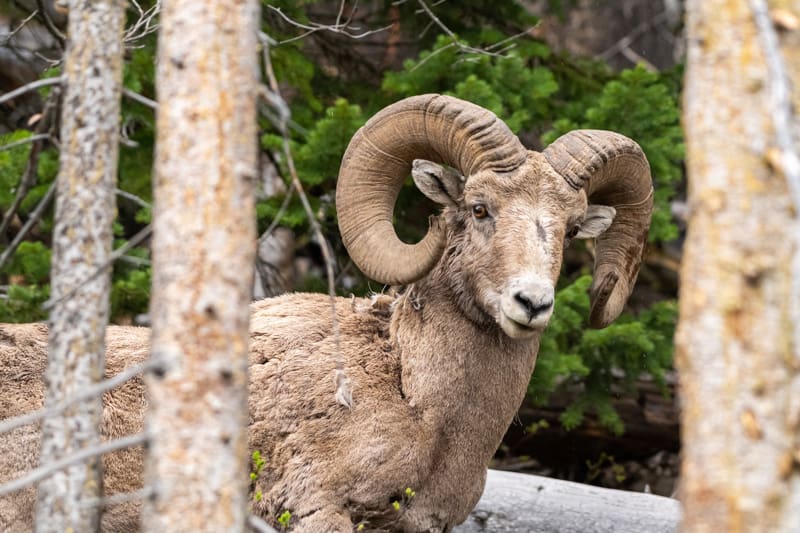
Wildlife in the Tower-Roosevelt Area
BIGHORN SHEEP: The Tower-Roosevelt area includes sheer cliffs and rock formations which makes it perfect for bighorn sheep and deer. We find sheep like the area around the Yellowstone River Picnic area as you’re driving into Lamar Valley.
BLACK BEARS: Tower is one of Yellowstone’s best spots to see black bears, especially around Calcite Springs Overlook. We’ve also seen many black bears around the Tower-Roosevelt junction, in the Petrified Tree area, as well as the drive from there to Phantom Lake.
Also, just west of Tower Junction, we hear the Blacktail Plateau Drive dirt road offers decent chances to see animals, but we’ve not been lucky to see wildlife in that area yet.
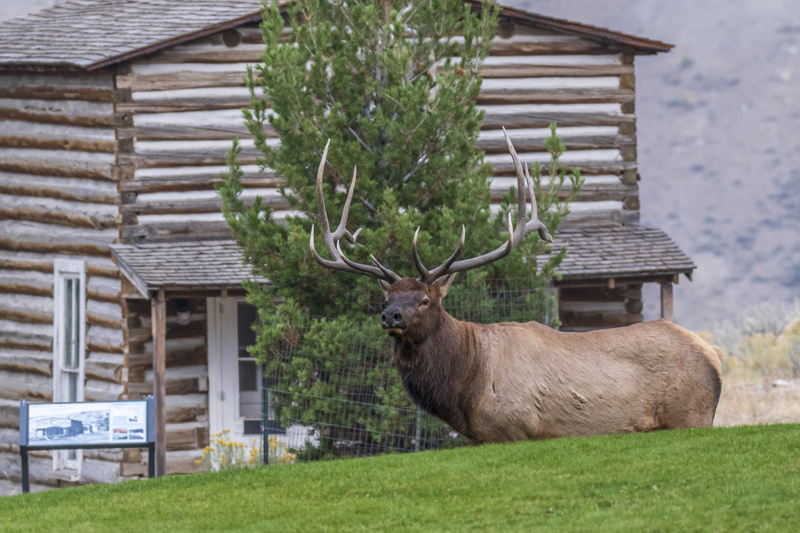
Wildlife in Mammoth Hot Springs
Planning a Yellowstone vacation in the fall is one of the best times to visit to see wildlife!
Around the second week of September, you’ll begin to hear the high pitched bugle of bull elk signaling the elk rut! The town of Mammoth is a terrific place to watch the male elk exert their dominance.
ELK: You’ll see elk in the Mammoth Hot Springs town and around the area year-round. As you’re exploring the town and hot springs trails, remember elk are wild animals, even if they seem accustomed to people.
Every year visitors get chased, trapped or injured by elk, particularly in the spring calving season and fall mating season. September is the elk rut
Bison also occasionally wander into Mammoth Hot Springs.
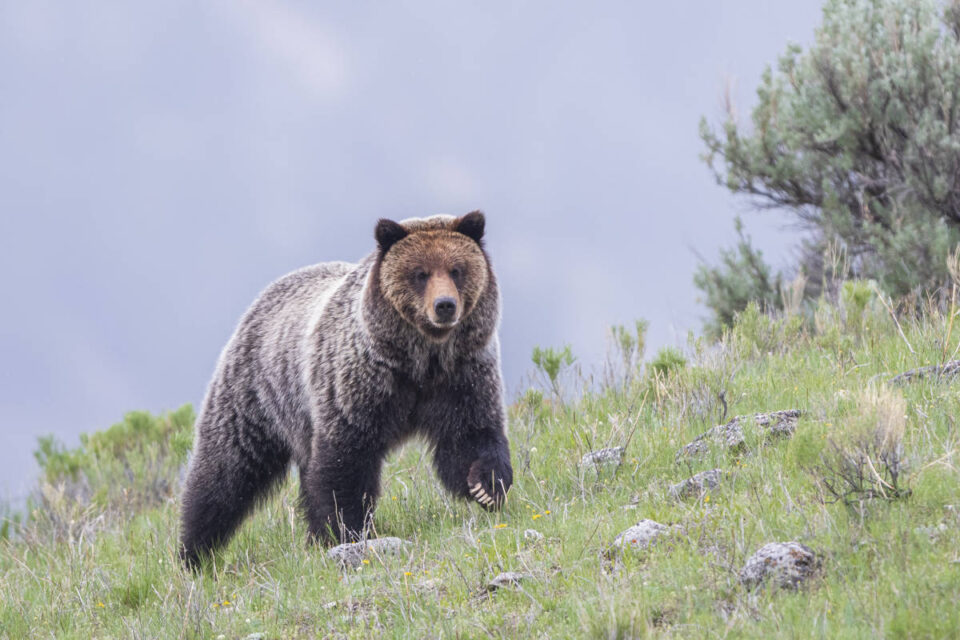
BEARS: Grizzly bears visit the area in the spring during calving season. We watched one bound down the hillside, cross the road by our car, then run toward the houses on the edge of Mammoth.
In the fall, bears are looking for berries and bull bison or elk that perished during the rut.
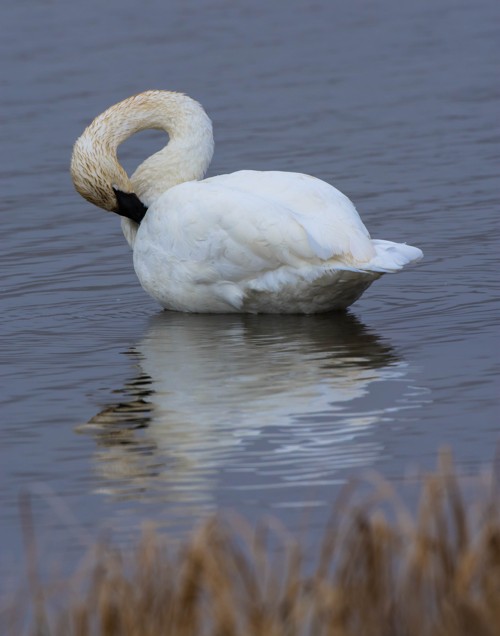
SWAN: As you drive from Mammoth Hot Springs to Norris, you’ll see Swan Lake. We usually always see a trumpeter swan or two in the lake.
In the area we’ve seen and photographed elk, bison, and grizzly bears.
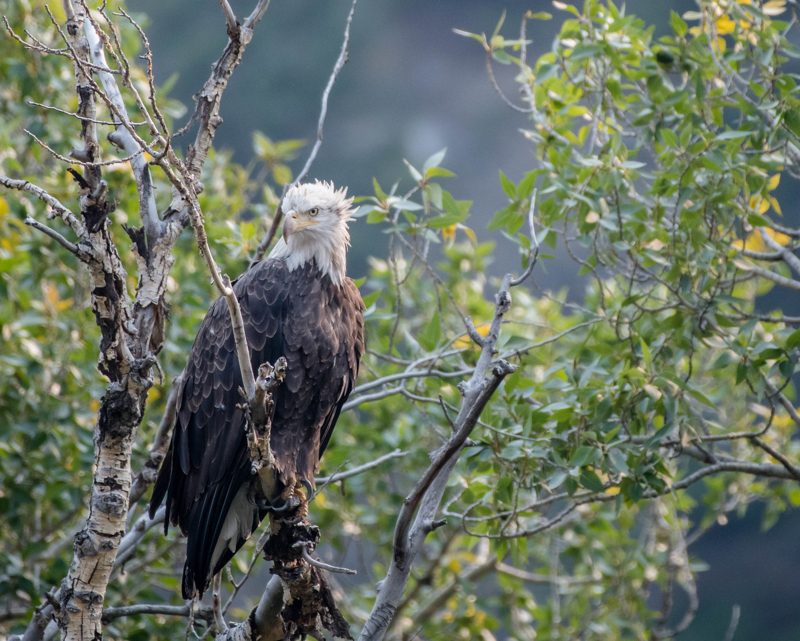
Wildlife Around the North Entrance
At the North Entrance near Gardiner, Montana, it’s one of the best places in Yellowstone National Park to see elk.
We like to stay in Gardiner and find deer and elk frequently roaming the town. It’s so cool to hear the elk bugle at night!
Other commonly seen animals around the North Entrance include bison, pronghorn and bighorn sheep. We usually see osprey and even bald eagles flying near the river.
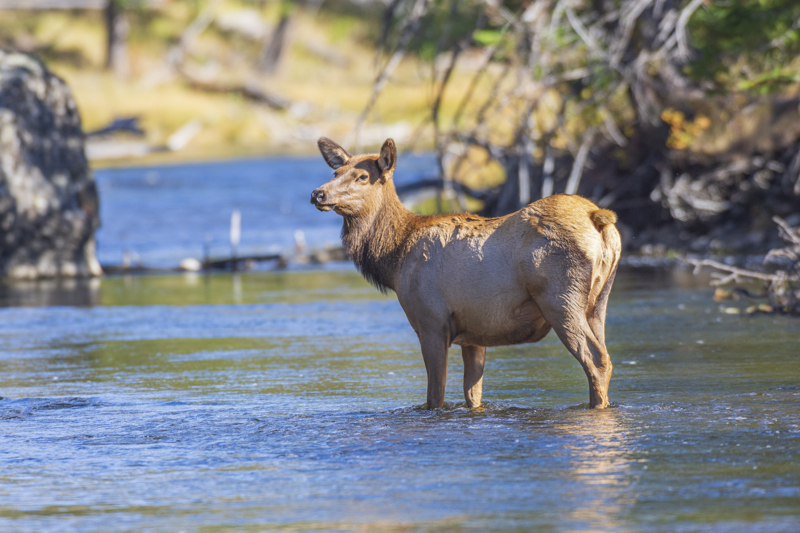
Wildlife in Norris, Gibbon and Madison
BISON: Be prepared for bison traffic jams in all of these areas! Remember to only stop when there’s a parking lot or pullout.
BEARS: Black and grizzly bears are often seen in the Norris area from Swan Lake to the Norris junction. We’ve seen them near the junction and in the Gibbon Meadows.
ELK: You can usually see elk in the meadows all along the Madison River from Madison to the West Entrance near West Yellowstone.
BALD EAGLES: There are frequent sightings of bald eagles along the Madison River in this area.
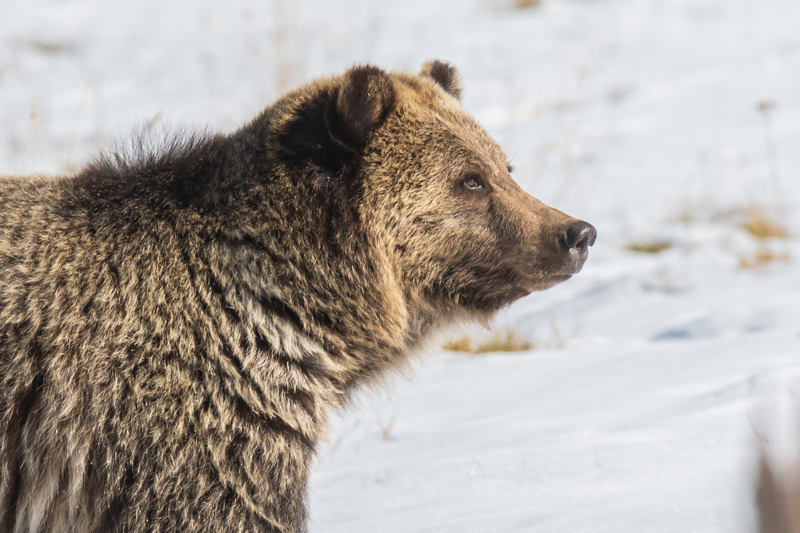
Wildlife Near Old Faithful
In the winter, the warm ground around the hydrothermal basins here provides access to vegetation for elk and bison.
BEARS: In the spring, the bison and elk that didn’t survive winter, known as winter-kill, attract black and grizzly bears to the Old Faithful area.
Many of the Old Faithful area day hikes near the Midway and Lower Geyser Basins may be closed for bear management in spring. Old Faithful, however, is always open to visitors.
BISON: Be prepared for bison jams in the area. Be sure to only stop when there’s a parking lot or pullout. If you visit Yellowstone in the winter, it’s cool to see the dark bison contrasted against the white snow. Often the bison will have a face covered with snow from digging looking for vegetation.
WOLVES: There is a wolf pack in the area, although we’ve not seen them, only heard them.
BIRDS: We’ve often seen osprey and bald eagles flying around the Firehole River.
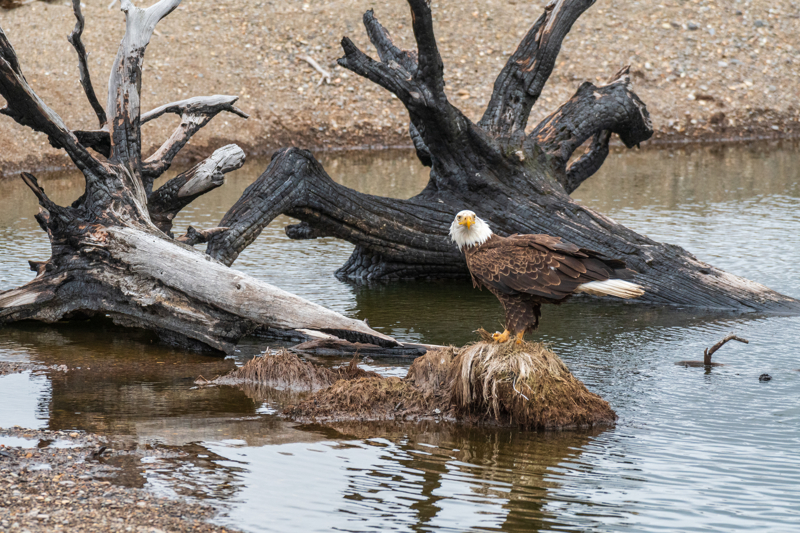
Wildlife at Yellowstone Lake & Fishing Bridge
FISH: Yellowstone Lake is home to North America’s largest population of Yellowstone cutthroat trout. Fishing is no longer allowed here, but from Fishing Bridge you may be able to see these trout and other fish.
BIRDS: This abundance of fish attracts many predators to the area like river otters, white pelicans, osprey, and bald eagles. We often see bald eagles as we drive along the edge of Yellowstone Lake.
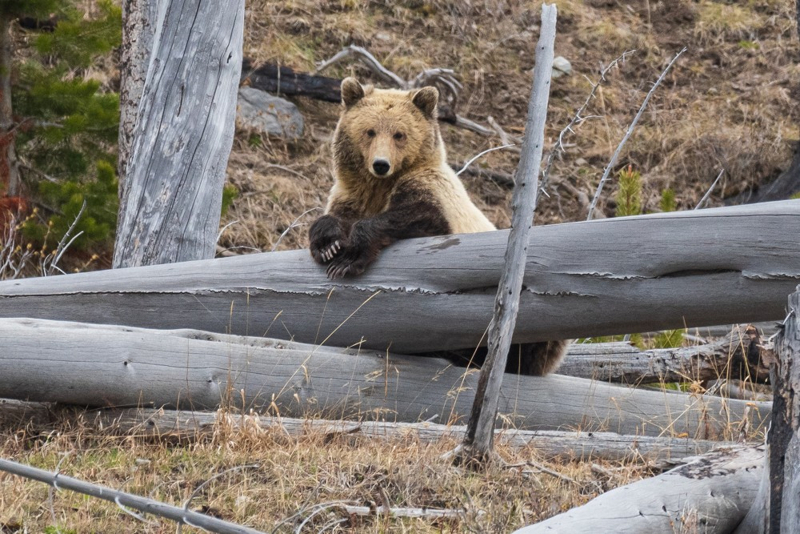
BEARS: Watch for black bears and grizzly bears in the Fishing Bridge area, Pelican Valley, Sedge Bay, and near Lake Butte Overlook. We’ve been lucky to watch bears and cubs many times in the Sedge Bay and Lake Butte Overlook areas.
Due to the density of grizzly bears in this area, the Fishing Bridge RV Park is Yellowstone’s only campground where tent camping is not allowed—only hard-sided vehicles are allowed.
You will also see elk and bison around the shores of Yellowstone Lake.
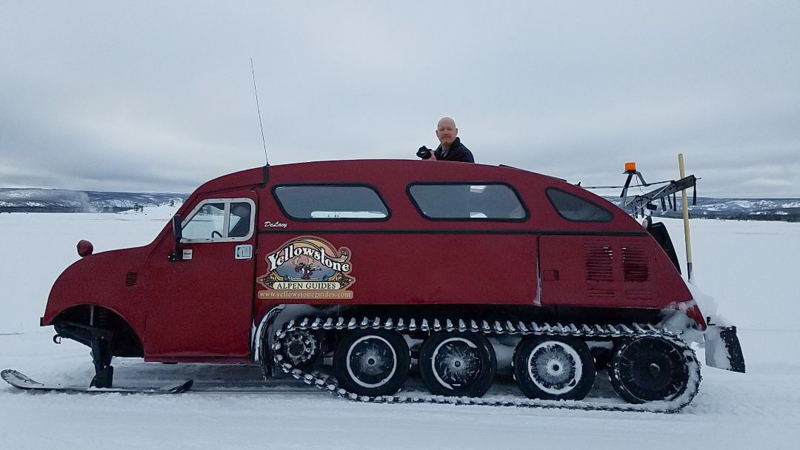
Yellowstone Guided Wildlife Viewing Tours
Most Yellowstone tours focus on viewing the geothermal features and wildlife in the park like grizzly and black bear, wolves, elk, moose, bison, and bald eagles.
The winter Yellowstone snow coach tours are so fun. We really like Alpen Guides and their bombariers where you can stick your head out of the top to capture awesome photos!
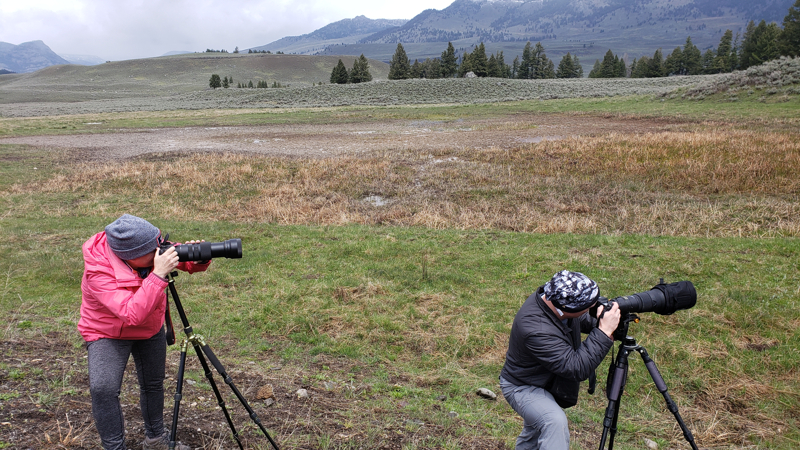
Recommended Gear for Wildlife Photography in Yellowstone
Wildlife photography requires patience and split-second reactions. The best cameras for wildlife photography include features you need specifically for taking pictures of animals like good burst mode, decent buffer depth, and fast and efficient autofocus.
Keep in mind the wildlife photography lens you use will be the biggest expense. You could have the best camera, but a poor quality lens could produce soft images that aren’t as sharp as you hoped. There are zoom lenses that allow for flexibility, giving you a range of focal lengths you can use. And there are prime lenses that produce sharper images than the zoom lenses, but they are more expensive because they are faster and have a much wider maximum aperture.
→ Check out these tips for photographing wildlife!
Plan a Yellowstone Vacation
- Yellowstone National Park Travel Guide
- Things to Do at Yellowstone National Park
- Best Time to Visit Yellowstone National Park
- Best Time to Visit Yellowstone for Wildlife
- Yellowstone Tours
Places to stay in West Yellowstone
- Holiday Inn, West Yellowstone
- ClubHouse Inn, West Yellowstone
- Kelly Inn, West Yellowstone
- West Yellowstone hotels!
Places to stay in Gardiner
- Yellowstone Gateway Inn, Gardiner – full kitchen and comfy bed, one of our favorite places to stay!
- Park Hotel Yellowstone, Gardiner – charming place to stay and loved by guests!
- Absaroka Lodge, Gardiner – beautiful location with river views!
- Gardiner hotels!
Places to stay in Cooke City or Silver Gate
- Sunny Log Home on the Creek, Silver Gate (VRBO) – the most AMAZING location with an awesome fireplace and comfy bed!
- High Country Motel and Cabins – local owners who love what they do, and make you feel so welcome!
